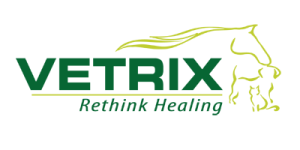The History of Vetrix
Before there was VETRIX, the use of extracellular matrix (ECM) has widely infiltrated the human field of medicine.  Originally developed at Purdue University, a team of researchers discovered the regenerative capabilities of small intestinal submucosa (SIS) ECM as a material able to fully regrow tissue of various kinds. As the team of scientists imagined the possibilities of regenerative medicine, the rights to SIS were farmed to various companies throughout the human medical industry. To one company the cardiovascular rights were granted, to another SIS was given for use to treat burn and dermatologic patients, and still to another, Cook Biotech, the material has essentially been adopted as the standard of care for hernia repair. As the various applications were researched for human implications, there was a void in veterinary medicine. While the FDA requires animal clinical testing prior to human use, all applications for SIS ECM were proven through published studies in various journals of medicine. Built upon the shoulders of proven research, VETRIX was born. Today VETRIX serves as the gold standard in veterinary regenerative medicine, offering the most scientifically proven biological scaffold on the market.
Originally developed at Purdue University, a team of researchers discovered the regenerative capabilities of small intestinal submucosa (SIS) ECM as a material able to fully regrow tissue of various kinds. As the team of scientists imagined the possibilities of regenerative medicine, the rights to SIS were farmed to various companies throughout the human medical industry. To one company the cardiovascular rights were granted, to another SIS was given for use to treat burn and dermatologic patients, and still to another, Cook Biotech, the material has essentially been adopted as the standard of care for hernia repair. As the various applications were researched for human implications, there was a void in veterinary medicine. While the FDA requires animal clinical testing prior to human use, all applications for SIS ECM were proven through published studies in various journals of medicine. Built upon the shoulders of proven research, VETRIX was born. Today VETRIX serves as the gold standard in veterinary regenerative medicine, offering the most scientifically proven biological scaffold on the market.
VETRIX harnesses the natural capabilities of the patients existing cells, to fully migrate into the biological scaffold. Once the patient’s native cells have migrated into the VETRIX bioscaffold, the cells lay down collagen which, in turn, share signals to differentiate the cells into the appropriate tissue. With this site-specific healing capability, VETRIX can fully regenerate tissue ranging from skin, muscular defects, intestinal lining and others. Even a damaged cornea can be fully restored using VETRIX Ocular Discs.
Vetrix LLC is the leading provider of veterinary extracellular matrix (ECM) technologies, providing an environment for cells to naturally regenerate via an acelluar graft. Vetrix, which is derived from porcine small intestinal submucosa (SIS), can be surgically implanted on any tissue area in need of repair, including the skin, tendons and ligaments, cartilage, muscles, bones and more. The product repairs and regenerates cells in damaged areas by mimicking the natural functionality of the surrounding area, healing wounds quicker than ever.

